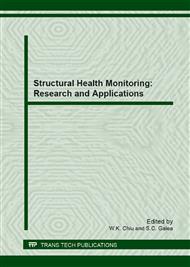[1]
Su, Z., L. Ye, and Y. Lu, Guided Lamb waves for identification of damage in composite structures: a review. Journal of Sound and Vibration, 2006. 295(3-5): pp.753-780.
DOI: 10.1016/j.jsv.2006.01.020
Google Scholar
[2]
Grondel, S., et al., Fatigue crack monitoring of riveted aluminium strap joints by Lamb wave analysis and acoustic emission measurement techniques. NDT & E International, 2002. 35(3): pp.137-146.
DOI: 10.1016/s0963-8695(01)00027-5
Google Scholar
[3]
Staszewski, W., B.C. Lee, and R. Traynor, Fatigue crack detection in metallic structures with Lamb waves and 3D laser vibrometry. Measurement Science and Technology, 2007. 18: p.727–739.
DOI: 10.1088/0957-0233/18/3/024
Google Scholar
[4]
Leong, W.H., et al., Structural health monitoring using scanning laser vibrometry: III. Lamb waves for fatigue crack detection. Smart Materials and Structure, 2005. 14: p.1387–1395.
DOI: 10.1088/0964-1726/14/6/031
Google Scholar
[5]
Kim, S.B. and H. Sohn, Continuous fatigue crack monitoring without baseline data. Fatigue & Fracture of Engineering Materials & Structures, 2008. 31: p.644–659.
DOI: 10.1111/j.1460-2695.2008.01254.x
Google Scholar
[6]
Kim, S.B., et al., Applications of an instantaneous damage detection technique to plates with additional complexities. Journal of Nondestructive Evaluation, 2010. 29: p.189–205.
DOI: 10.1007/s10921-010-0077-1
Google Scholar
[7]
Rokhlin, S.I., et al., Nondestructive sizing and localization of internal microcracks in fatigue samples. NDT & E International, 2007. 40: p.462–470.
DOI: 10.1016/j.ndteint.2007.02.001
Google Scholar
[8]
Kim, J.-Y. and S.I. Rokhlin, Surface acoustic wave measurements of small fatigue cracks initiated from a surface cavity. International Journal of Solids and Structures, 2002. 39: p.1487–1504.
DOI: 10.1016/s0020-7683(01)00286-4
Google Scholar
[9]
Ihn, J.-B. and F.-K. Chang, Detection and monitoring of hidden fatigue crack growth using a built-in piezoelectric sensor/actuator network: I. Diagnostics. Smart Materials and Structure, 2004. 13: pp.609-620.
DOI: 10.1088/0964-1726/13/3/020
Google Scholar
[10]
Staszewski, W.J., C. Boller, and G.R. Tomlinson, Health Monitoring of Aerospace Structures: Smart Sensor Technologies and Signal Processing. New York:: J. Wiley, 2004.
DOI: 10.1002/0470092866
Google Scholar
[11]
Mujica, L.E., et al., Q-statistic and T2-statistic PCA-based measures for damage assessment in structures. Structural Health Monitoring, 2011. 10(5): pp.539-553.
DOI: 10.1177/1475921710388972
Google Scholar
[12]
Cammarata, M., et al., Application of principal component analysis and wavelet transform to fatigue crack detection in waveguides. Smart Structures and Systems, 2010. 6(4): pp.349-362.
DOI: 10.12989/sss.2010.6.4.349
Google Scholar
[13]
Mathwork Inc., Statistics Toolbox, User's Guide,Version 4. 2001.
Google Scholar
[14]
Li, F.C., et al., Multiple damage assessment in composite laminates using a Doppler-effect-based fiber-optic sensor. Measurement Science and Technology, 2009. 20: p.115109.
DOI: 10.1088/0957-0233/20/11/115109
Google Scholar
[15]
Wang, D., et al., Probabilistic damage identification based on correlation analysis using guided wave signals in aluminum plates. Structural Health Monitoring, 2010. 9(2): pp.133-144.
DOI: 10.1177/1475921709352145
Google Scholar
[16]
Lu, Y., et al., Time-domain analyses and correlations of Lamb wave signals for damage detection in a composite panel of multiple stiffeners. Journal of Composite Materials, 2009. 43(26): pp.3211-3230.
DOI: 10.1177/0021998309345332
Google Scholar


